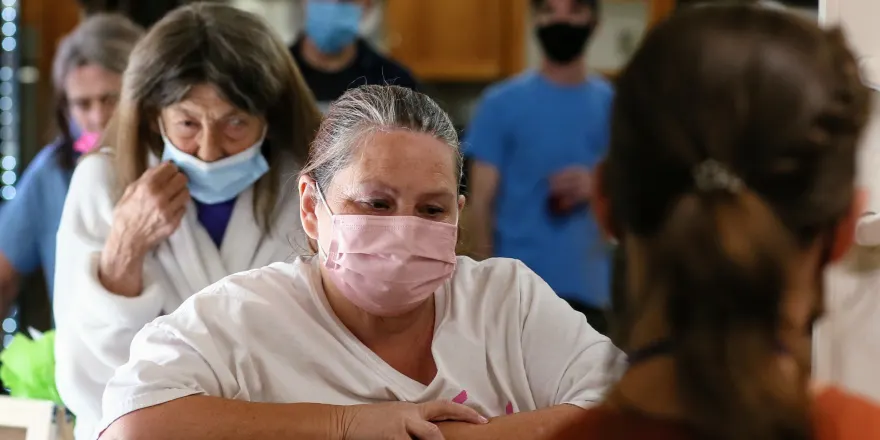Sarah Lawrence College Health Advocacy Blog (click to read full article with photos)

Previously unhoused people have access to medicine and compassion as residents of the INN Between.
Hospice care is designed to provide “compassionate care for people in the last phases of incurable disease so that they may live as fully and comfortably as possible.” It offers physical, emotional, and spiritual support to people facing life-limiting illnesses and their families. Jillian Olmsted witnessed this compassionate care when her mother and stepfather were at the end of their lives. She saw how vital this care could be while her neighborhood was fighting the development of a hospice center. This proposed center, now known as the INN Between, is a residential hospice center providing care for 50 patients. Impassioned by her own experience, Ms. Olmsted volunteered her time in the center’s early days.
"Instead of dwelling on the sadness of the person’s suffering, Ms. Olmsted focuses on the fact that The INN Between ‘prevented someone from suffering and dying on the street. We gave them the ability to feel loved again."
In many ways, the INN Between is a typical assisted living center with hospice patients. Patients with advanced, life-limiting illnesses are referred there for comfort and care. What sets the INN Between apart is the patient population. The residents of the INN Between are people experiencing homelessness. The population is what initially gave residents of a Salt Lake City neighborhood pause; they didn’t want a shelter built in their backyard.
Advocates for the center educated their neighbors and showed them the importance of this type of care and the humanity of the patients within. Hospice care across patient populations increases the quality of life for whatever time a patient has left. Patients in hospice care also live longer. Along with providing pain management, and emotional and spiritual support, hospice care providers also help with personal and home hygiene. For patients at the INN Between, their hospice experience is the first time they have been cared for and have had the ability to care for themselves in many years.
As a resident, Patti Larsen told the LA Times, “‘it’s different here. You’re accepted…You’re safe, you know.” Jillian Olmsted is not surprised. ‘“Time and time again, people come here to die and end up choosing to live. The secret, she said, is providing simple human necessities like food, shelter, and community.” Now, the neighborhood has coalesced around the center, forming the Friends of INN Between to problem-solve and lend support.
Jillian Olmsted transitioned from volunteer to staff member and is now the center's executive director. Her personal experience with hospice care solidified her mission to make this care accessible to the most vulnerable populations. People who experience homelessness encounter massive barriers to receiving long-term medical care. Typical homeless shelters cannot take medically-complex people. They often lack the space to accommodate medical equipment and don’t have care teams in place to handle medical crises. If a patient isn’t sick enough to warrant a hospital stay, they are often discharged back to the street. To receive hospice care, a person must have a physical address, putting this vital service out of reach for many. For homeless residents of Salt Lake City, the INN Between is helping bridge this gap.
INN Between’s staff provides information and education to local medical care teams and community outreach services to alert them about the INN Between’s resources and aid referrals to the center. Referred patients can live at the center, receive care, and live out their final days with compassion, community, dignity, and respect, the four core values of the center.
The center's residents are also able, if they wish, to participate in building the center's community. During the early stages of the COVID pandemic, physically able patients started to do some household chores to fill in the gaps created by the staff shortages. Today, a chore chart hangs in the common area, and residents can sign up for tasks to do if they feel up to it. The residents also have a council to problem-solve issues that may come, like how often and during what times the Keurig coffeemaker should be available.
The residents, when able, also provide care for one another. It’s not uncommon to see one resident pushing another’s wheelchair to the dining room or clearing someone’s lunch tray away. They care for and cuddle Rodger, the resident cat. They were given the opportunity to imagine the center’s mission, and they helped develop the four core values of the INN Between: compassion, community, dignity, and respect. For many residents, having input in their living conditions and their community is something they haven’t experienced for quite some time.
For staff, this work can be challenging. Watching people die, especially people who experienced a lot of past trauma, can be draining for staff. But under Ms. Olmsted’s leadership, the staff team and the residents grieve together and celebrate the bright spots. Staff and residents can participate in a candle-lighting ceremony and honor line, where stories of the deceased are shared. The center hosts a community memorial ceremony if the patient requests it before their death. Every resident who passes has an obituary written and posted on the INN Between’s website, memorializing people often overlooked.
Instead of dwelling on the sadness of the person’s suffering, Ms. Olmsted focuses on the fact that The INN Between “prevented someone from suffering and dying on the street. We gave them the ability to feel loved again.”
With neighborhood support and demonstrated value, The INN Between is looking to expand from caring for 50 residents to supporting 72 patients. Ms. Olmsted is hopeful that they will soon be able to provide more care to people who would otherwise fall through the cracks.
For more information on The INN Between, please visit: https://tibhospice.org/
